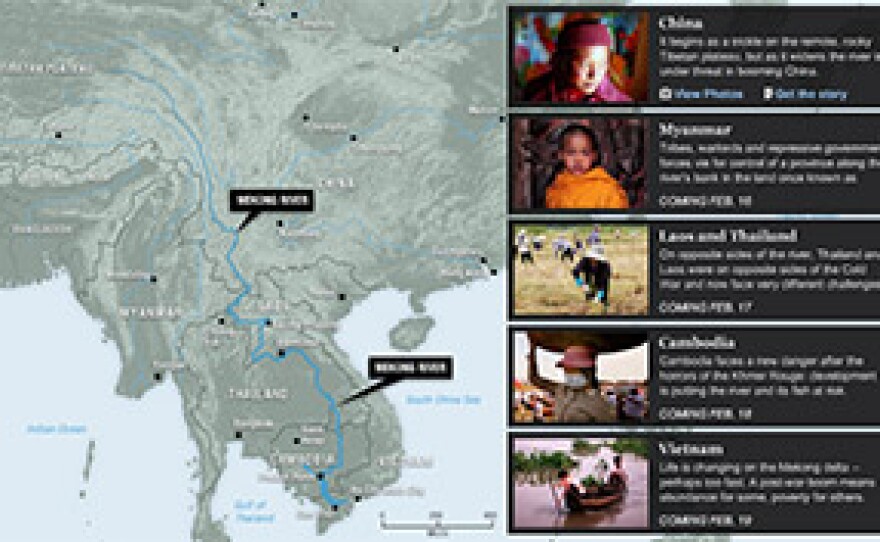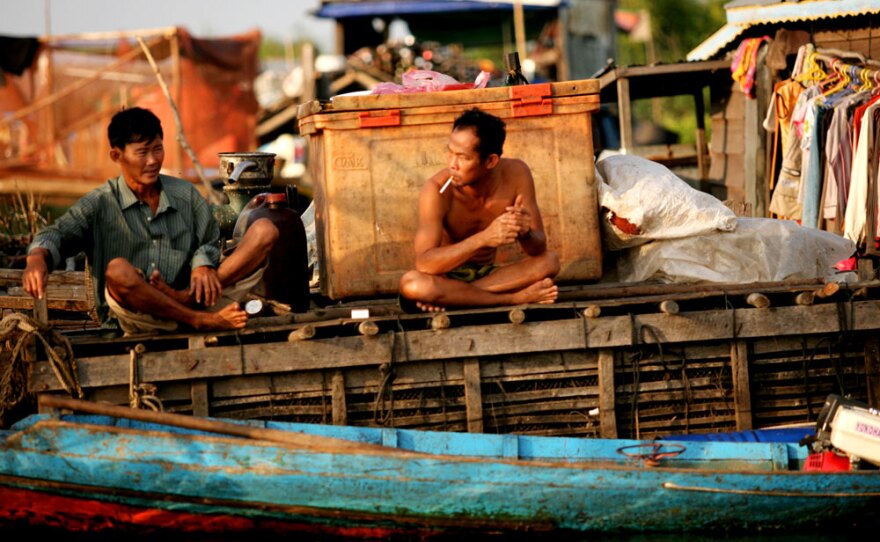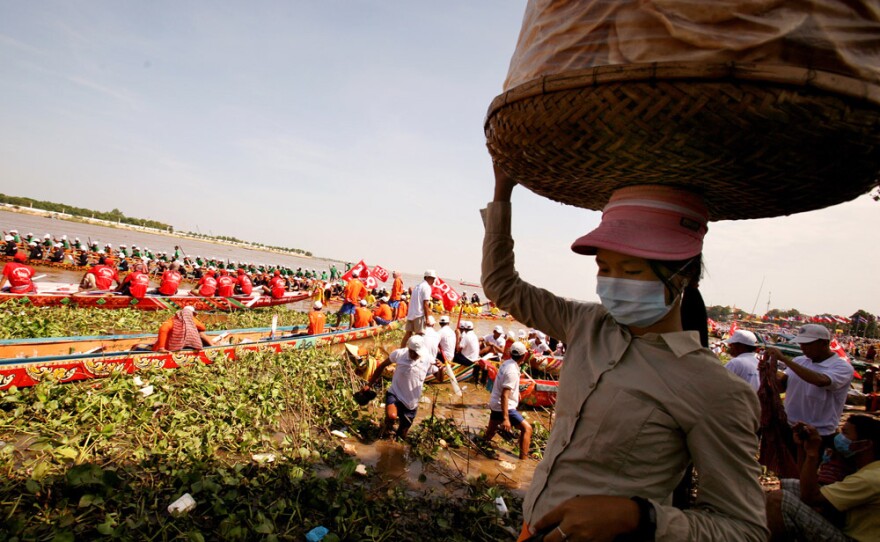Cambodia is one of the poorest countries in Asia. But it hasn't always been that way. The Khmer once ruled a vast kingdom that covered not just Cambodia but parts of Vietnam, Thailand and Laos, too.
The empire had its capital at Angkor, near the present-day city of Siem Reap in northwest Cambodia. At its peak, nearly 1 million people lived in the city of Angkor — at a time when London was still a town of 20,000 or so.

The empire's crowning architectural achievement was the magnificent temple of Angkor Wat, one of several dozen temples built by the Angkorian kings, the ruins of which now draw tourists from all over the globe.
Water was key to the Khmer kingdom's prosperity: for irrigation, for drinking and for food from the fish that swam up the Mekong into the Tonle Sap River and the lake of the same name.
"No river, no life. No water, no life in Cambodia," says Pyyoak, my guide.
Invading armies also came up the Mekong in an effort to conquer the Khmer kingdom in the 12th century, a story told in the bas reliefs at Angkor's Bayon temple.
Pyyoak says the Champa, or Cham, came up the Mekong from the south, from what is now Vietnam, and occupied Angkor for four years, from 1177 until 1181.
The stone carvings depict the battle in vivid detail, right down to the uniforms worn by the competing armies.
Pyyoak points to another set of carvings on the wall that depict better times in the kingdom: floating villages, bountiful harvests and an abundance of fish in the river and the lake.

"From here, you can see the daily life of the people; they live on the Mekong River. You can see the floating village and some business people, they are selling on the Mekong River," he explains.
"And life was very good for the people of Angkor then — better than for Cambodians today?" I ask Pyyoak.
"Yes, I think that is right," he replies.
Floating Worlds Under Threat
The floating villages still exist today — the closest on the Tonle Sap Lake, just 20 minutes south of the Angkor ruins by car, then a half-hour more by boat. The Tonle Sap is the largest lake in Southeast Asia and, scientists say, the key to the biodiversity of the entire Mekong basin, thanks to the seasonal flooding of the Mekong and the lake.
Many of the floating villages are populated by ethnic Vietnamese, who just might be distant relatives of the Cham warriors who came up the Mekong to fight more than 800 years ago.
These villages are almost completely self-contained — with floating sawmills, metal shops and grocery boats — a water world where children are born, raised and sometimes die without ever having set foot on land. Batteries power their houseboats, complete with TVs, DVD players and karaoke machines. There are even floating bars to help slake the thirst of day-tripping tourists from nearby Angkor Wat.
But it's a hard life, says fisherman Do Van Thanh, 47, one made even more difficult by a dwindling catch — half what it used to be just a few years ago, he says.
His friend, Tran Van Loi, also 47, is no biologist, but he understands very well the relationship between the river, the lake and the fish, and he smells trouble.
There are more people fishing, he says, and that means fewer fish.
In the past, adult fish would lay their eggs in the Mekong. After hatching, the small fish would find their way to the Tonle Sap, grow up here, and then return to the Mekong, he says. But with so many people fishing, more fish are being caught younger, before they can lay their eggs, he says, and he knows that's not good.
Tran says if he could quit fishing now, he would — but there's no other way to make money.
Making enough money to survive is still a challenge for the majority in Cambodia, one of the poorest countries in Asia. It's a country that would probably be far better off had its recent history not included the four-year-long terror of the Maoist Khmer Rouge. From 1975 to 1979, the regime led by Pol Pot controlled the country, a time when an estimated 1.7 million Cambodians — a quarter of the country's population — died.
Dark Chapter
More than 30 years later, the country experienced a reckoning of sorts last November at the joint U.N. Cambodian Tribunal in the capital, Phnom Penh, where the Mekong and the Tonle Sap rivers converge. The man on trial was Kaing Guek Eav, known by the alias Comrade Duch, an aging Khmer Rouge commander who ran the infamous S-21 prison, also known as Tuol Sleng.
The first senior Khmer Rouge leader to be tried, Duch was charged with crimes against humanity — which included savage beatings, extraction of fingernails and toenails with pliers, and electrocution. The torture ended for almost all of the prisoners at the killing field of Choeung Ek. An estimated 16,000 people were imprisoned at Tuol Sleng; fewer than a dozen are known to have survived.
In court, Duch admitted his guilt and begged for forgiveness.
"I still and forever wish to most respectfully and humbly apologize to the dead souls," he said through an interpreter. "To the survivors, I stand by my acknowledgment of all crimes inflicted on you at S-21. I acknowledge them in both the moral and legal context."
It was an extraordinary moment for many who have waited more than 30 years for some sort of justice and closure. Duch has yet to be sentenced. He claimed, just a few days after this dramatic testimony, that he was a "cog in the machine" who was "just following orders."

Living In And For The Present
But many Cambodians haven't paid much attention to the tribunal, the majority of the population having been born after that dark period in the country's history.
And Phnom Penh — the city the Khmer Rouge leaders once emptied of people in their bid to create an agrarian, utopian state — now has more people than ever.
The capital is attracting more foreign investment and more rural Cambodians looking for work, most of it in construction. The streets of the city are now choked with motorcycles and the Lexuses and Cadillac Escalades of the nouveau riche. The vehicles jockey for position as they pass the construction site of the Gold Tower 42, soon to be the city's newest and tallest skyscraper.
On the riverfront, giant vacuums suck sand from the bottom of the Mekong, which will be used to fill the city's famous Boeung Kak Lake, the site of a new high-end business and residential complex.
It is a controversial project, and a sensitive one, too, which explains why hard men with guns object to my visit to the site. Land grabs such as this one are the scourge of Southeast Asia, not just Cambodia: ordinary citizens displaced by rapacious developers and corrupt government officials.
Last year was better. The big fish would come down from the Tonle Sap and we could catch enough, and sell enough, to pay for fuel with a little left over for food. But every year it seems to get a little worse.
Too Many People, Too Few Fish
Heading downriver from Phnom Penh, the scenery changes quickly. The new skyscrapers and casinos of the capital quickly give way to banana trees, rice and corn. The vast majority of Cambodia's 15 million people live in the countryside, where there is not much choice when it comes to earning a living: farming or fishing.
On this stretch of the Mekong, about 20 miles south of the capital, those who fish have the same complaints as the fishermen on the Tonle Sap.
Nguyen Quynh Thi and her husband haul in their second set of nets for the day, and it's the same as the first: nothing. It's nearly noon, but they will stay out a bit longer, they say, though Nguyen isn't quite sure why.
"Last year was better. The big fish would come down from the Tonle Sap and we could catch enough, and sell enough, to pay for fuel with a little left over for food. But every year it seems to get a little worse," she says.
Too many people chasing too few fish. Farther downstream, just short of where the Mekong flows into neighboring Vietnam, I stop to talk to one last fisherman.
Kong Hout, 48, says he and his family eat fish for breakfast, lunch and dinner. He catches it himself and says there is still enough to go around — for now, if you know where to look.
But what would happen, I ask, if there are no more fish. He doesn't hesitate.
"It would be an age of darkness," he says, with no trace of irony. Then, he thinks about it some more and comes up with something that, for him, is an even more horrible thought:
"Maybe, we'll have to start eating fish from cans."
Producer Tung Ngo contributed to this report.
Next, the journey down the Mekong ends in Vietnam.
Copyright 2023 NPR. To see more, visit https://www.npr.org. 9(MDAzMjM2NDYzMDEyMzc1Njk5NjAxNzY3OQ001))















